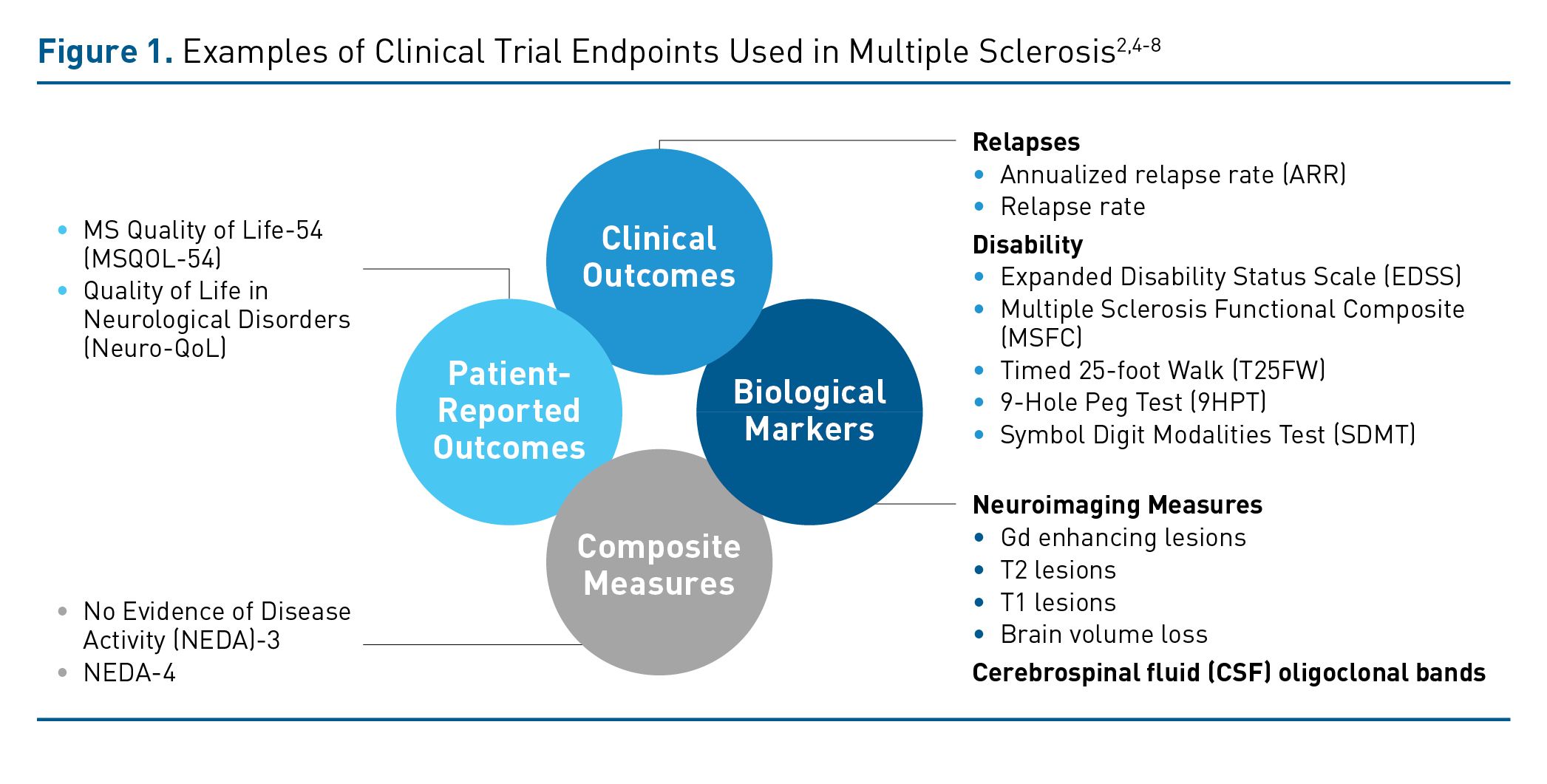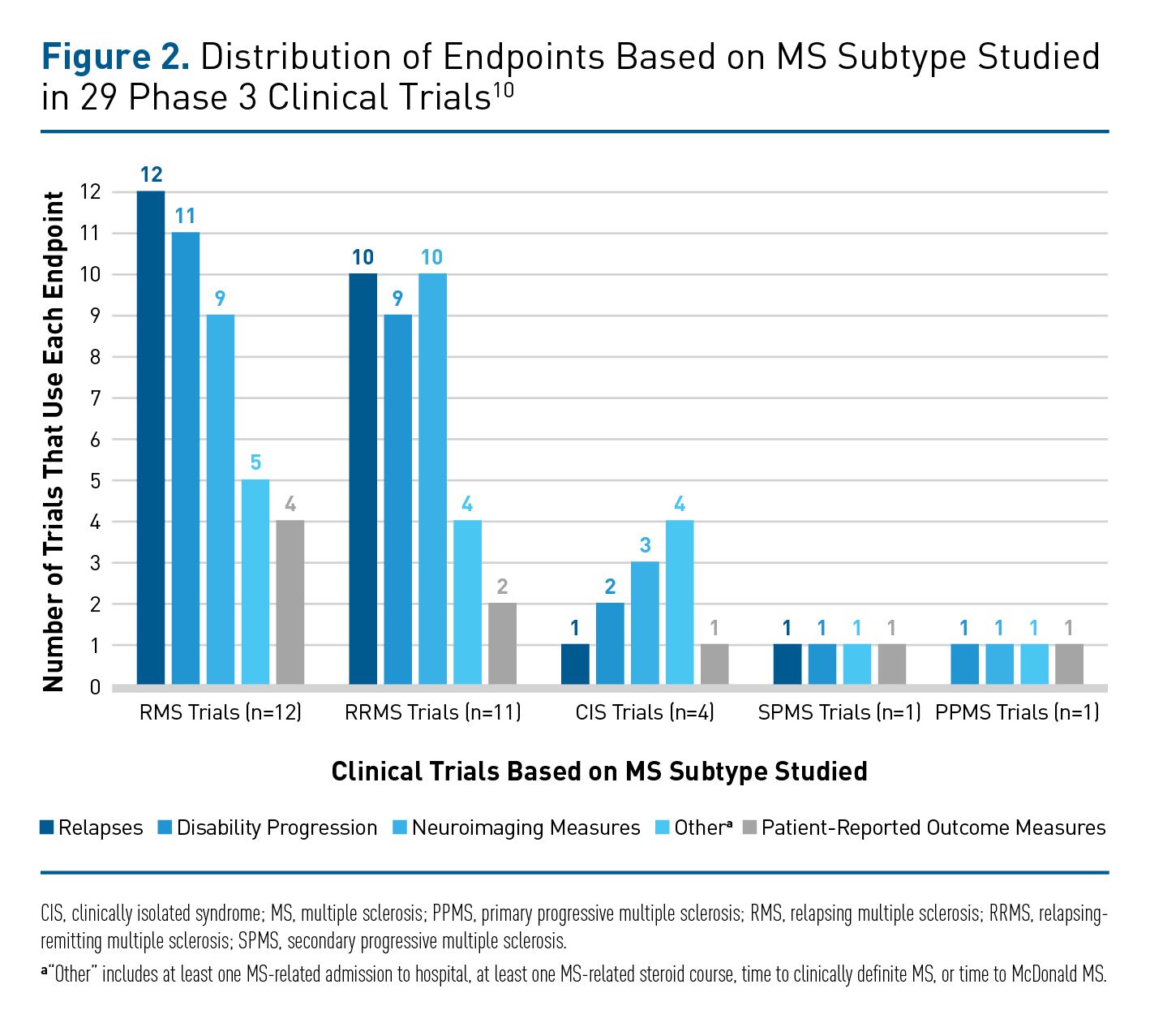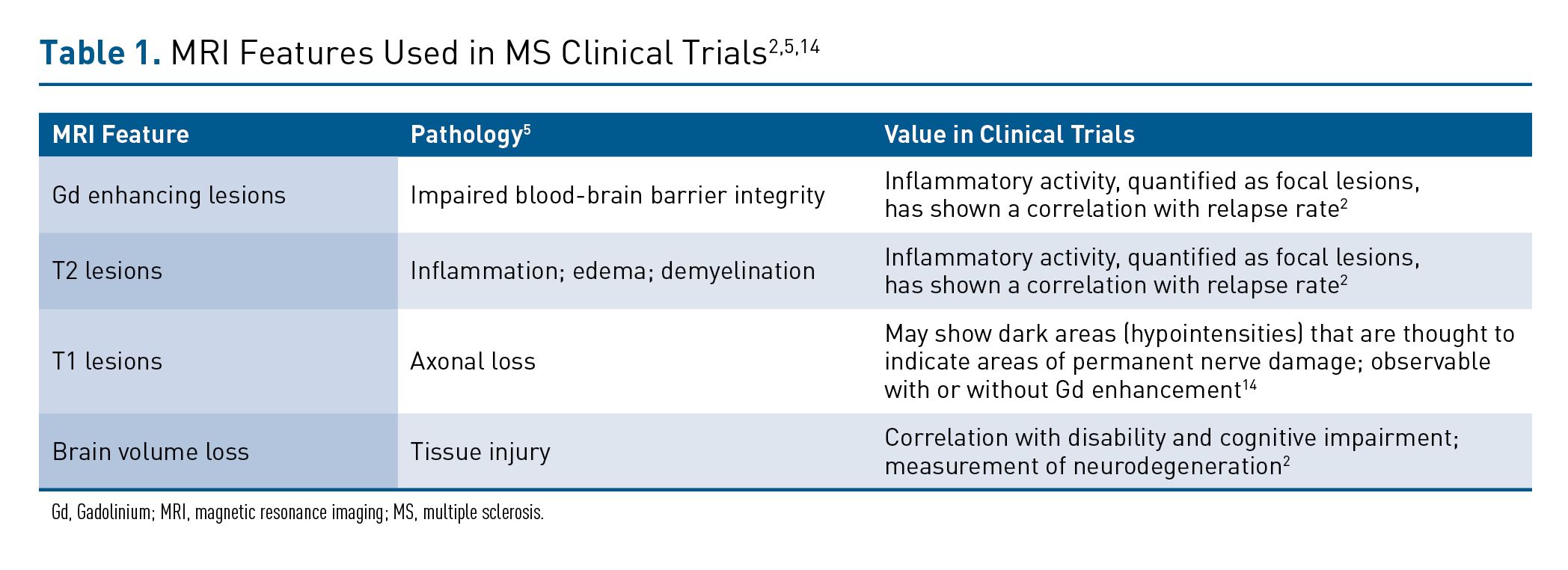Publication
Article
Supplements and Featured Publications
Population Health Guide to the Evolution of Endpoints in Multiple Sclerosis
Author(s):
THIS PUBLICATION WAS SPONSORED BY JANSSEN PHARMACEUTICALS, INC.
DETERMINING RELATIVE EFFICACY OF PRODUCTS HAS BEEN A CHALLENGE FOR FORMULARY DECISION MAKERS
Twenty disease-modifying therapies (DMTs) are currently available in the growing armamentarium for multiple sclerosis (MS) and are redefining the disease course.1,2 This influx of new therapies, however, has made it challenging for payers to enforce formulary restrictions and utilization management criteria given the lack of updated, evidence-based, well-researched, and well-referenced consensus guidelines.3 Scant guidelines and the lack of head-to-head trials often lead to contested decisions between payers and providers.3
A better understanding of the results of clinical trials that support the efficacy and use of DMTs in treatment can help payers manage formularies based on scientific analysis rather than marginal cost differentials. Matching the most appropriate medication to the right patient at the right time can help improve outcomes and member satisfaction, decrease loss of wages, and lower health utility costs.4
THE NUMBER OF ENDPOINTS USED TO DETERMINE DMT EFFICACY HAVE INCREASED OVER TIME, MAKING IT EVEN MORE DIFFICULT TO COMPARE PRODUCTS
Our understanding of MS pathophysiology is continuously evolving. The disease has variable clinical presentations, an array of factors affect its pathophysiology at the individual level, and there is a long time delay between DMT intervention and outcome. As such, measuring the impact of DMTs is far from the straightforward use of a single biomarker, it instead requires a complex duet between what patients can report and what providers can assess.5
There are currently 4 major types of outcome measures used to assess DMTs in clinical trials: clinical outcomes (eg, measures for relapses and disability), biological markers (eg, magnetic resonance imaging [MRI] scans, neurofilament light chain [NFL], and cerebrospinal fluid [CSF] oligoclonal bands), composite measures that consist of some combination of clinical outcomes and biological markers, and patient-reported outcomes [PROs] that measure quality of life (see Figure 1).2,4-8
New options within each category are being utilized in clinical trials. For example, while the Expanded Disability Status Scale (EDSS) and focal MRI lesions continue to remain the standard of assessment of disease activity, newer parameters such as brain volume loss (BVL) and NFL are contributing modern dimensions to capturing disease progression.2

SOME ENDPOINTS ARE SPECIFIC TO SUBTYPES OF MS
The plethora of DMTs effective in relapsing-remitting MS (RRMS) have not always achieved similar slowing of disability in progressive forms of MS (ie, primary progressive MS [PPMS] and secondary progressive MS [SPMS]), likely due to their distinct mechanisms of pathophysiology.9
Due to the vastly different clinical presentations of relapsing and progressive forms of MS, DMTs that target these differences must be assessed using different endpoints. For example, relapses do not occur frequently in progressive forms of MS and, therefore, this subtype requires alternative endpoints.2 Figure 2 summarizes the endpoints used in 29 pivotal phase 3 trials among the various MS subtypes, including RRMS, relapsing MS (RMS), SPMS, PPMS, and clinically isolated syndrome (CIS).10

ENDPOINTS HAVE EVOLVED WITH OUR UNDERSTANDING OF THE COMPLEX PATHOPHYSIOLOGY OF MS
Measurement of DMT efficacy has improved, but there is more to be done. There is a mutual relationship between our understanding of MS pathophysiology and the tools used to measure its treatment: better understanding leads to better endpoints, and better endpoints lead to better understanding.2 As shown in Figure 12,4-8, current endpoints can be broadly categorized into 4 groups, each capturing distinct pathophysiologic processes of MS. For example, relapse endpoints measure inflammation, whereas disability endpoints reflect accumulation of clinical disability from inflammatory or neurodegenerative disease processes.2
Relapse
Relapse is believed to be predictive of disease progression in short-term trials for relapsing MS and is defined as the “acute worsening of function” that lasts for at least 24 hours, usually lasting for several days or weeks, followed by an improvement that lasts for at least 1 month. Relapse endpoints can be readily adapted in the clinical setting as their measurement is a matter of accurate and objective identification of such events.6
The most commonly used summary measure of relapse in clinical trials is annualized relapse rate (ARR), calculated by total number of relapses experienced by the cohort divided by the person-years at risk. Relapse rate is another common choice in clinical trials.6
There is evidence to suggest that the relapse rate is reduced by 17% every 5 years as the disease progresses.6 Intra-patient variations in disease presentation can confound clinical analysis, requiring additional endpoints to better understand DMT efficacy.2
Disability
Disability, typically measured using physical examination, is an important measure to track physical and cognitive impairment over time.9,10
One of the most widely used neurologic examinations in MS clinical trials is EDSS, which predominantly measures physical impairment and is universally familiar to MS clinicians.9,11 Although EDSS is expected to remain the most accepted clinical outcome measure for the near future, it has been criticized for its inter-rater variability, heavy emphasis on walking, limited impact of cognitive impairment, and nonlinear scale.2 The variability among examiners has been addressed with the use of electronic scoring of EDSS in clinical trials.2
Limitations of EDSS, however, have led to newer measures for disability such as Multiple Sclerosis Functional Composite (MSFC), which is measured on a linear scale and includes cognition.4 It is a multidimensional test battery that integrates various individual performance measures: Timed 25-foot Walk (which measures walking speed), 9-Hole Peg Test (which measures dexterity and upper extremity motor function), Low Contrast Letter Acuity (which measures visual impairment), and Symbol Digit Modalities Test (SDMT) (which measures cognitive processing speed and sustained attention).7 MSFC can be quickly and reliably assessed and gives a z-score on a continuous scale.2 Z-scores, however, are abstract and difficult to interpret clinically, limiting the widespread use of MSFC.2
Minimal Assessment of Cognitive Function in Multiple Sclerosis (MACFIMS) and Brief International Cognitive Assessment for Multiple Sclerosis (BICAMS) are two common neuropsychological batteries used to assess cognitive impairment.12 Individual tests to assess cognitive impairment include SDMT and Paced Auditory Serial Addition Test (PASAT).12
Biological markers
MRI lesions
Although clinical outcomes are predominant in trials because they more closely reflect patients’ symptomatology, MRI measures of disease activity have become valuable secondary tools for DMT assessment.10 MRI lesions have become critical in the development of new DMTs because new lesions appear more frequently than clinical relapses and are thought to strongly predict rates of relapse.13 This is helpful when clinical trials of relatively short duration must be conducted for a disease with a prolonged clinical course.2
MRI lesions are objective, quantifiable, and highly sensitive in detecting subclinical disease activity.2 Examples of methods to measure MRI lesions are described in Table 12,5,14, which include Gadolinium (Gd) enhancing lesions, T2 lesions, and T1 lesions.
Perhaps the biggest disadvantage of MRI lesions is that they do not accurately reflect the degree of clinical disability.2

BVL
BVL, also known as brain atrophy, is thought to be a predictor of not only disability progression, but also cognitive impairment and neurodegeneration (see Table 1).2,5,14 MRI measures of BVL in MS have been proposed as a complementary approach to lesion assessment to facilitate the prediction of disability progression.15
Although there is strong evidence to support the use of BVL, adoption in clinical practice can be confounded by several sources of error related to technical factors. Appropriate management of these potential sources of error can ensure accuracy and reliability of BVL in clinical practice.16
BVL is now routinely incorporated into clinical trials.4 As technology continues to evolve, it can provide more granular detail on cortical pathology with the detection of white matter, deep central gray matter, and other lesions not typically seen using older methodologies.5
Fluid biomarkers
Clinical and neuroimaging measures remain the cornerstone of assessing DMT efficacy as the search for fluid biomarkers that could be easily obtained from serum has not yielded promising results.2 Although there are currently no established fluid biomarkers in use in clinical trials, NFL is among the most promising potential options.2 With better understanding, it may become the first fluid biomarker to be used in clinical trials and in the clinical setting.2
Measurement of CSF oligoclonal bands holds promise as a biomarker. However, its use is currently limited because it requires measuring levels in the CSF rather than in the blood.5
Composite measures
As there is no single endpoint that can capture the entire MS experience, composite measures offer more holistic endpoints. One such measure that offers progress in MS outcomes measurement is No Evidence of Disease Activity (NEDA). If, over a certain period, patients do not experience relapses or changes in disability or MRI activity, they can be classified as having achieved NEDA.2 This provides a simple “yes/no” endpoint for clinical trials.
NEDA is currently undergoing refinement as it remains unclear which specific outcomes should be included.2 The long-term prognostic value of NEDA-3 is being questioned because some patients who are correctly classified as having no disease activity later accrue disability.8 NEDA-4 has been proposed as an alternative endpoint which, in addition to relapses, disability worsening, and MRI lesions, also includes BVL change over time in order to provide a more comprehensive and balanced outcome for predicting long-term disease evolution.8
PROs
MS Quality of Life-54 (MSQOL-54) and Quality of Life in Neurological Disorders (Neuro-QoL) are the most frequently used PRO tools for people with MS and may potentially have a bigger role in MS care in the future.5
A PAYER POINT OF VIEW ON ASSESSING CLINICAL TRIALS IN MULTIPLE SCLEROSIS WITH MICHAEL J. FINE, MD, MEDICAL DIRECTOR AT HEALTH NET
What were the initial outcomes you were using in your earliest days of managing multiple sclerosis, especially when the market was largely self-injectables?
FINE: Initially, both clinical trials and payers used relapses and disability as measures of efficacy. However, over time, the MRI imaging demonstrated that MS continues to progress even in the absence of clinical relapses and new outcomes were needed.2
How has formulary management changed over time in this disease state with the increase in choice of orals?
FINE: More drug options resulted in more management with preferred drugs and step therapy.17 However, it also became apparent that the newer DMTs offered improved outcomes on MRI imaging and at least some drugs, including orals, needed to be offered to treatment-naïve patients.18,19
Is your formulary management more open with many MS choices or more closed with limited options and even preferred products or steps to non-preferred?
FINE: Most payer formularies exclude some MS drugs, especially when there are several with the same mechanism of action. Steps exist and most formularies offer many first-line options and step therapy is often limited to just one step.20
Do you manage intravenous differently than oral meds?
FINE: We account for various factors when managing drugs in MS, including but not limited to efficacy, safety, and “indicated subtype.”
How much is formulary coverage driven by outcome data versus marginal cost differentials?
FINE: Although it should not be, this is a constant debate at pharmacy and therapeutics (P&T) committees. After all, patients with MS suffer permanent harm and disability if their disease progresses.1 Furthermore, it is ethical to offer the most effective options without the delay that step therapy creates.
Which outcome data do you currently use most: ARR, disability scales, MRI lesions, BVL, NEDA, or PROs?
FINE: Outcome measures continue to evolve. Although there seem to be significant differences between specialists and payers, MRI lesions, NEDA, and BVL can be considered as the most impactful today. There is an urgent need to standardize optimal treatment goals by both neurologists and the FDA.
How does the lack of consistent outcome measures affect your ability to determine preferred MS products?
FINE: Significant challenges are created in determining relative efficacy of products when manufacturers develop data based on differing outcomes.
PERSONALIZING THERAPY CAN CHANGE THE WAY WE PRACTICE MEDICINE IN A BIG WAY
Science has made tremendous strides in MS, but we are certainly not there yet. It is important to look at the specifics because they are more predictive. In addition to reimbursement of DMTs, payers will also have to consider reimbursement of the emerging tools in order to adapt to an era of multiple treatment options approved by various endpoints. Our measurement tools are improving, but there is much to be done. We learn as we go.
REFERENCES
- National Multiple Sclerosis Society. Disease-modifying therapies for MS. Published online 2021. Accessed October 12, 2021. https://www.nationalmssociety.org/NationalMSSociety/media/MSNationalFiles/Brochures/Brochure-The-MS-Disease-Modifying-Medications.pdf
- Zhang Y, Salter A, Wallström E, Cutter G, Stüve O. Evolution of clinical trials in multiple sclerosis. Ther Adv Neurol Disord. 2019;12:175628641982654. doi:10.1177/1756286419826547
- A Payer Point of View on the Changing Multiple Sclerosis Treatment Spectrum, With Kenneth Snow, MD. Suppl Featur Publ. Published online April 5, 2018. Accessed September 24, 2021. https://www. ajmc.com/view/payer-pov-on-changing-ms-treatment-spectrum-with-snow
- Chitnis T, Prat A. A roadmap to precision medicine for multiple sclerosis. Mult Scler. 2020;26(5):522-532. doi:10.1177/1352458519881558
- Leist T. Toward personalized care for multiple sclerosis. Pract Neurol. Published online
February 2021:23-34. https://practicalneurology.com/articles/2021-feb/toward-personalized-care- for-multiple-sclerosis - Nicholas R, Friede T. Considerations in the design of clinical trials for relapsing multiple sclerosis. Clin Investig. 2012;2(11):1073-1083. doi:10.4155/cli.12.114
- Goldman MD, LaRocca NG, Rudick RA, et al. Evaluation of multiple sclerosis disability outcome measures using pooled clinical trial data. Neurology. 2019;93(21):e1921-e1931. doi:10.1212/WNL.0000000000008519
- Prosperini L, Ruggieri S, Haggiag S, Tortorella C, Pozzilli C, Gasperini C. Prognostic accuracy of NEDA-3 in long-term outcomes of multiple sclerosis. Neurol Neuroimmunol Neuroinflamm. 2021;8(6):e1059. doi:10.1212/NXI.0000000000001059
- Mills EA, Begay J, Fisher C, Mao-Draayer Y. Impact of trial design and patient heterogeneity on the identification of clinically effective therapies for progressive MS. Mult Scler. 2018;24(14):1795-1807. doi:10.1177/1352458518800800
- Gehr S, Kaiser T, Kreutz R, Ludwig WD, Paul F. Suggestions for improving the design of clinical trials in multiple sclerosis—results of a systematic analysis of completed phase III trials. EPMA J. 2019;10(4):425-436. doi:10.1007/s13167-019-00192-z
- National Multiple Sclerosis Society. Functional Systems Scores (FSS) and Expanded Disability Status Scale (EDSS). Published online 2021. Accessed October 13, 2021. https://www.nationalmssoci-ety.org/For-Professionals/Researchers/Resources-for-MS-Researchers/Research-Tools/Clinical-Study-Measures/Functional-Systems-Scores-(FSS)-and-Expanded-Disab
- Ruet A, Brochet B. Cognitive assessment in patients with multiple sclerosis: from neuropsychological batteries to ecological tools. Ann Phys Rehabil Med. 2020;63(2):154-158. doi:10.1016/j.rehab.2018.01.006
- Reich DS, Lucchinetti CF, Calabresi PA. Multiple sclerosis. Longo DL, ed. N Engl J Med. 2018;378(2):169-180. doi:10.1056/NEJMra1401483
- National Multiple Sclerosis Society. Magnetic resonance imaging (MRI). Published online 2021. Accessed October 13, 2021. https://www.nationalmssociety.org/Symptoms-Diagnosis/Diagnosing-Tools/MRI
- Sastre-Garriga J, Pareto D, Battaglini M, et al. MAGNIMS consensus recommendations on the use of brain and spinal cord atrophy measures in clinical practice. Nat Rev Neurol. 2020;16(3):171-182. doi:10.1038/s41582-020-0314-x
- Zivadinov R, Jakimovski D, Gandhi S, et al. Clinical relevance of brain atrophy assessment in mul-tiple sclerosis. Implications for its use in a clinical routine. Expert Rev Neurother. 2016;16(7):777-793. doi:10.1080/14737175.2016.1181543
- Owens GM. Managed care aspects of managing multiple sclerosis. Am J Manag Care. 2013;19(16):S307-S312.
- Rae-Grant A, Day GS, Marrie RA, et al. Comprehensive systematic review summary: Disease-modifying therapies for adults with multiple sclerosis: Report of the Guideline Development, Dissemination, and Implementation Subcommittee of the American Academy of Neurology. Neurology. 2018;90(17):789-800. doi:10.1212/WNL.0000000000005345
- Cerqueira JJ, Compston DAS, Geraldes R, et al. Time matters in multiple sclerosis: can early treatment and long-term follow-up ensure everyone benefits from the latest advances in multiple sclerosis? J Neurol Neurosurg Psychiatry. 2018;89(8):844-850. doi:10.1136/jnnp-2017-317509
- MMIT. Reality check: multiple sclerosis. 2021. Accessed October 19, 2021. https://info.mmitnet-work.com/hubfs/MMIT-Reality%20Check-MS-1Q2021-final.pdf
